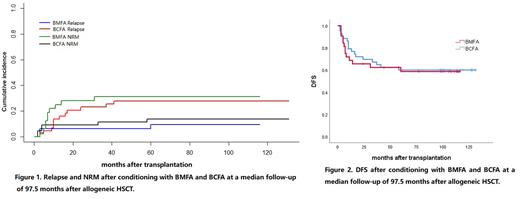Abstract
Objective: To evaluate the safety and long-term efficacy of melphalan (Mel) instead of cyclophosphamide (Cy) in the modified busulfan/cyclophosphamide (Bu/Cy) regimen as a novel myeloablative conditioning regimen for patients with acute myeloid leukemia undergoing allogeneic hematopoietic stem cell transplantation (HSCT).
Methods: The clinical data of 76 patients with acute myeloid leukemia undergoing allogeneic HSCT from November 2007 to October 2011 were retrospectively analyzed, of which 32 patients received Bu +Mel +Fludarabine(Flu) +Cytarabine(Ara-C) (BMFA)regimen(Bu 3.2mg· kg-1 · d-1 by vein, -8, -7,-6d; Mel 140mg·m-2·d-1, -5d; Flu 30mg·m-2·d-1,-4, -3, -2d; Ara-C 2g·m-2·d-1. -4, -3, -2d), 44 cases received Bu+ Cy +Flu +Ara-C(BCFA)as modified Bu/Cy regimen (Bu 3.2mg· kg-1 · d-1 by vein, -9,-8, -7d; Cy 50mg· kg-1· d-1,-6, -5d; Flu 30mg·m-2·d-1,-4, -3, -2d; Ara-C 2g·m-2·d-1. -4, -3, -2d ). Anti-thymocyte globulin (ATG) was added to the haploid transplantation and unrelated donor transplant conditioning regimen. Both groups of patients have treated with Cyclosporine A (CsA)/ Tacrolimus (FK506) + short-course methotrexate (MTX)±mycophenolate mofetil (MMF) for graft-versus-host disease (GVHD) prevention. Regimen-related toxicity, engraftment rates, GVHD, and Long-term outcome including relapse, non-relapse mortality (NRM), disease-free survival (DFS), and overall survival (OS) were compared between the two groups.
Results: Both groups of patients achieved neutrophil engraftment after transplantation. The incidence of grade Ⅲ-Ⅳ° oral mucositis and diarrhea in the BMFA group was higher than in the BCFA group (P=0.016, P=0.028). The incidence of Ⅱ~Ⅳ° acute GVHD in the BMFA group was also higher than in the BCFA group (37.5% vs. 15.9%,P=0.032). There was no significant difference in the incidence of chronic GVHD between the two groups. With a median follow-up of 97.5 months (2-131months), the cumulative incidence of relapse at 100 months in the BMFA group was lower than in the BCFA group (9.37% vs. 27.7%, P=0.055), and the incidence of NRM in BMFA group was 31.7% and 13.8% in BCFA group (P=0.076).The OS were (59.0±8.8)% and(59.7±7.6)% (P=0.778), and DFS were((58.7±8.8)% and(60.0±7.5)% (P=0.786) were comparable between BMFA group and BCFA group. In the BMFA group, univariate analysis showed that III-IV° oral mucositis,III-IV° diarrhea, and II-IV°aGVHD were risk factors for NRM (P values, 0.015, 0.015, 0.006, respectively), multivariate analysis showed that II~IV°aGVHD was an independent risk factor for NRM(P=0.025).
Conclusion: The conditioning regimen of melphalan instead of cyclophosphamide for allogeneic HSCT of acute myeloid leukemia has a low relapse rate. In the long-term follow-up, DFS and OS were similar to those of the modified Bu/Cy regimen. However, the prevention of regimen-related toxicity and the treatment and intervention of acute GVHD should be considered to reduce non-relapse mortality.
Disclosures
No relevant conflicts of interest to declare.
Author notes
Asterisk with author names denotes non-ASH members.


This feature is available to Subscribers Only
Sign In or Create an Account Close Modal